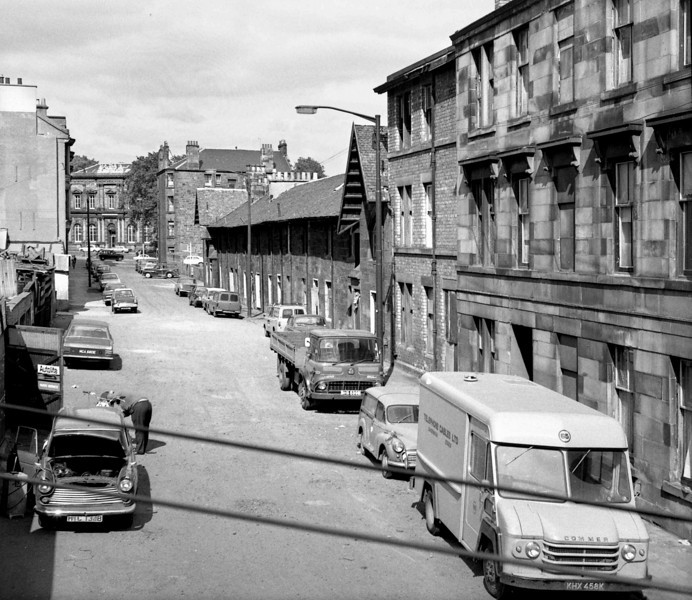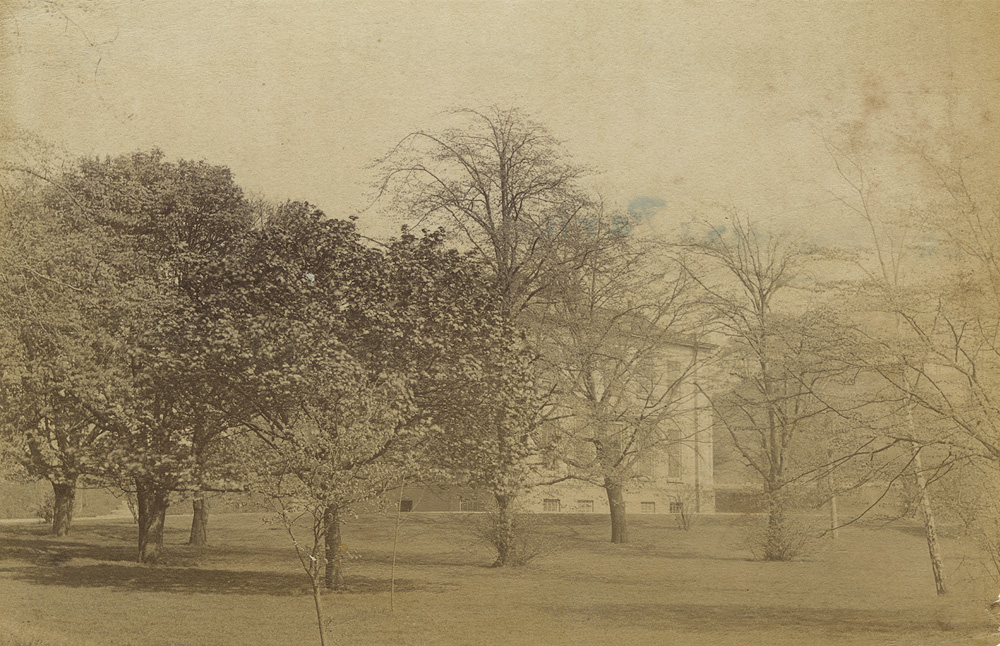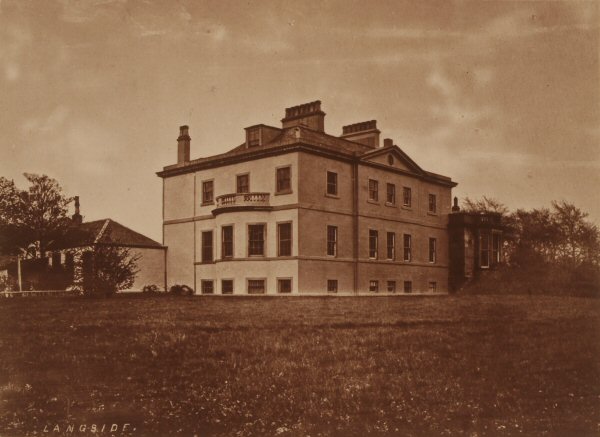
Neale Thomson
Neale Thomson was one of Glasgow’s great philanthropists, who lived at Camphill House in Queens Park, and founded the famous Crossmyloof bakery.
The Thomson family were successful in the cotton industry. Robert Thomson (1771-1831) was a partner with his father (also Robert, 1742-1820) in Robert Thomson & Sons, whose Adelphi Cotton Works in Hutchesontown was said to have been the first in Glasgow to manufacture cotton goods. He purchased land at Camphill in 1778, and had Camphill House built shortly thereafter. The architect is thought to be David Hamilton (1768-1843), who built the similar Aitkenhead House (in Kings Park) in 1806.
Neale Thomson was born at Camphill in 1807. The family business fell into his hands when his father Robert died in 1831, followed shortly thereafter by Neale’s brothers, two in 1833 and the third in 1843.
He became known for the care of his workforce, introducing shorter hours before the law on this was passed. He also encouraged workers to open savings accounts, including matching their contributions with his own, and established a bakery in Crossmyloof for his workers, where good quality bread could be bought far more cheaply than was normally the case. This proved such a success that shops soon opened, with large crowds gathering to meet the delivery vans, and the experiment in philanthropy grew into a flourishing business.
In 1855 he commissioned Alexander Greek Thomson to build terraced housing for his workforce in Baker Street . There were apparently two terraces originally , but by 1964 only one remained, and this appears to have been demolished in the 1970s. In this photo c 1971 the cottages with their overhanging eaves are on the right, and Langside Halls is visible at the end of the road. There are further photos on The Virtual Mitchell website from 1964 .

Baker Street, Crossmyloof
Hugh MacDonald was given a tour of the bakery and described it in detail in his Rambles Round Glasgow , calling it possibly the largest bakery in the Queen’s Dominion.
In 1852 Thomson acquired Langside House , a large elegant mansion on the highest point in Langside, bulit by Robert Adam in 1777. He was responsible for the development of the villas around Mansionhouse Road. Thomson acquired the land of Pathhead Farm adjacent to Camphill in 1854, and in 1857 sold it to the city for the construction of what became known as Queen’s Park He did so at a lower price than he had paid, despite the land’s increasing value, for the benefit of his fellow citizens. He died at Camphill, after a long illness, on 26 June 1857.
His biography appears in MacLehose’s biography of 100 Great Glaswegian men , including an account of his competitors’ efforts to undermine his business. They repeatedly accused him of selling underweight bread, which he defending vigorously in letters to both the Glasgow Herald and Courier.

Camphill House by Duncan Brown
Camphill House and its grounds were added to Glasgow Corporation’s Queen’s Park in 1894 . The building was converted into a museum in 1895-1896 and contained displays of costume and relics relating to the Battle of Langside, which was fought nearby in 1568. The museum closed in the 1980s and the building was converted into flats.

Langside House
Langside House survived until the 1980s, but has now been replaced by the modern housing of Langside Gardens .
The bakery continued in operation until 1880, and some of the buildings still survive. The Glad Cafe now sits on part of the site, and organised their Doors Open Day around the history of Neale Thomson in 2016. They sell a “Crossmyloaf” in his honour.
More information on Crossmyloof and Langside can be found in the Council’s Langside Heritage Trail leaflet.
{3557955:KI8RHMKG};{3557955:KCMSM95N};{3557955:8RS5KZH6};{3557955:DVZN7ZQ7};{3557955:BJE7PPZA};{3557955:ZAEEK5BB};{3557955:64AZH8FZ};{3557955:QECP65F9}
vancouver
asc
0
348
%7B%22status%22%3A%22success%22%2C%22updateneeded%22%3Afalse%2C%22instance%22%3A%22zotpress-ae8b8ee4d4085bf6d12453070c99da7a%22%2C%22meta%22%3A%7B%22request_last%22%3A0%2C%22request_next%22%3A0%2C%22used_cache%22%3Atrue%7D%2C%22data%22%3A%5B%7B%22key%22%3A%22KI8RHMKG%22%2C%22library%22%3A%7B%22id%22%3A3557955%7D%2C%22meta%22%3A%7B%22numChildren%22%3A1%7D%2C%22bib%22%3A%22%3Cdiv%20class%3D%5C%22csl-bib-body%5C%22%20style%3D%5C%22line-height%3A%201.35%3B%20%5C%22%3E%5Cn%20%20%3Cdiv%20class%3D%5C%22csl-entry%5C%22%20style%3D%5C%22clear%3A%20left%3B%20%5C%22%3E%5Cn%20%20%20%20%3Cdiv%20class%3D%5C%22csl-left-margin%5C%22%20style%3D%5C%22float%3A%20left%3B%20padding-right%3A%200.5em%3B%20text-align%3A%20right%3B%20width%3A%201em%3B%5C%22%3E1.%3C%5C%2Fdiv%3E%3Cdiv%20class%3D%5C%22csl-right-inline%5C%22%20style%3D%5C%22margin%3A%200%20.4em%200%201.5em%3B%5C%22%3EDictionary%20of%20Scottish%20Architects%20-%20Crossmyloof%20Buildings%20%5BInternet%5D.%20%5Bcited%202016%20Dec%2027%5D.%20Available%20from%3A%20%3Ca%20href%3D%27http%3A%5C%2F%5C%2Fwww.scottisharchitects.org.uk%5C%2Fbuilding_full.php%3Fid%3D214049%27%3Ehttp%3A%5C%2F%5C%2Fwww.scottisharchitects.org.uk%5C%2Fbuilding_full.php%3Fid%3D214049%3C%5C%2Fa%3E%3C%5C%2Fdiv%3E%5Cn%20%20%3C%5C%2Fdiv%3E%5Cn%3C%5C%2Fdiv%3E%22%2C%22data%22%3A%7B%22itemType%22%3A%22webpage%22%2C%22title%22%3A%22Dictionary%20of%20Scottish%20Architects%20-%20Crossmyloof%20Buildings%22%2C%22creators%22%3A%5B%5D%2C%22abstractNote%22%3A%22%22%2C%22date%22%3A%22%22%2C%22url%22%3A%22http%3A%5C%2F%5C%2Fwww.scottisharchitects.org.uk%5C%2Fbuilding_full.php%3Fid%3D214049%22%2C%22language%22%3A%22%22%2C%22collections%22%3A%5B%22CAR6MXPM%22%5D%2C%22dateModified%22%3A%222017-01-15T17%3A04%3A22Z%22%7D%7D%2C%7B%22key%22%3A%22BJE7PPZA%22%2C%22library%22%3A%7B%22id%22%3A3557955%7D%2C%22meta%22%3A%7B%22numChildren%22%3A1%7D%2C%22bib%22%3A%22%3Cdiv%20class%3D%5C%22csl-bib-body%5C%22%20style%3D%5C%22line-height%3A%201.35%3B%20%5C%22%3E%5Cn%20%20%3Cdiv%20class%3D%5C%22csl-entry%5C%22%20style%3D%5C%22clear%3A%20left%3B%20%5C%22%3E%5Cn%20%20%20%20%3Cdiv%20class%3D%5C%22csl-left-margin%5C%22%20style%3D%5C%22float%3A%20left%3B%20padding-right%3A%200.5em%3B%20text-align%3A%20right%3B%20width%3A%201em%3B%5C%22%3E1.%3C%5C%2Fdiv%3E%3Cdiv%20class%3D%5C%22csl-right-inline%5C%22%20style%3D%5C%22margin%3A%200%20.4em%200%201.5em%3B%5C%22%3EThe%20old%20country%20houses%20of%20the%20old%20Glasgow%20gentry%3A%20LXVI.%20Langside%20%5BInternet%5D.%20%5Bcited%202016%20Dec%2027%5D.%20Available%20from%3A%20%3Ca%20href%3D%27http%3A%5C%2F%5C%2Fgdl.cdlr.strath.ac.uk%5C%2Fsmihou%5C%2Fsmihou066.htm%27%3Ehttp%3A%5C%2F%5C%2Fgdl.cdlr.strath.ac.uk%5C%2Fsmihou%5C%2Fsmihou066.htm%3C%5C%2Fa%3E%3C%5C%2Fdiv%3E%5Cn%20%20%3C%5C%2Fdiv%3E%5Cn%3C%5C%2Fdiv%3E%22%2C%22data%22%3A%7B%22itemType%22%3A%22webpage%22%2C%22title%22%3A%22The%20old%20country%20houses%20of%20the%20old%20Glasgow%20gentry%3A%20LXVI.%20Langside%22%2C%22creators%22%3A%5B%5D%2C%22abstractNote%22%3A%22%22%2C%22date%22%3A%22%22%2C%22url%22%3A%22http%3A%5C%2F%5C%2Fgdl.cdlr.strath.ac.uk%5C%2Fsmihou%5C%2Fsmihou066.htm%22%2C%22language%22%3A%22%22%2C%22collections%22%3A%5B%22CAR6MXPM%22%5D%2C%22dateModified%22%3A%222016-12-27T11%3A58%3A11Z%22%7D%7D%2C%7B%22key%22%3A%22QECP65F9%22%2C%22library%22%3A%7B%22id%22%3A3557955%7D%2C%22meta%22%3A%7B%22numChildren%22%3A1%7D%2C%22bib%22%3A%22%3Cdiv%20class%3D%5C%22csl-bib-body%5C%22%20style%3D%5C%22line-height%3A%201.35%3B%20%5C%22%3E%5Cn%20%20%3Cdiv%20class%3D%5C%22csl-entry%5C%22%20style%3D%5C%22clear%3A%20left%3B%20%5C%22%3E%5Cn%20%20%20%20%3Cdiv%20class%3D%5C%22csl-left-margin%5C%22%20style%3D%5C%22float%3A%20left%3B%20padding-right%3A%200.5em%3B%20text-align%3A%20right%3B%20width%3A%201em%3B%5C%22%3E1.%3C%5C%2Fdiv%3E%3Cdiv%20class%3D%5C%22csl-right-inline%5C%22%20style%3D%5C%22margin%3A%200%20.4em%200%201.5em%3B%5C%22%3ETheGlasgowStory%3A%20Langside%20House%20%5BInternet%5D.%20%5Bcited%202016%20Dec%2027%5D.%20Available%20from%3A%20%3Ca%20href%3D%27http%3A%5C%2F%5C%2Fwww.theglasgowstory.com%5C%2Fimage%5C%2F%3Finum%3DTGSB00294%26t%3D2%27%3Ehttp%3A%5C%2F%5C%2Fwww.theglasgowstory.com%5C%2Fimage%5C%2F%3Finum%3DTGSB00294%26t%3D2%3C%5C%2Fa%3E%3C%5C%2Fdiv%3E%5Cn%20%20%3C%5C%2Fdiv%3E%5Cn%3C%5C%2Fdiv%3E%22%2C%22data%22%3A%7B%22itemType%22%3A%22webpage%22%2C%22title%22%3A%22TheGlasgowStory%3A%20Langside%20House%22%2C%22creators%22%3A%5B%5D%2C%22abstractNote%22%3A%22%22%2C%22date%22%3A%22%22%2C%22url%22%3A%22http%3A%5C%2F%5C%2Fwww.theglasgowstory.com%5C%2Fimage%5C%2F%3Finum%3DTGSB00294%26t%3D2%22%2C%22language%22%3A%22%22%2C%22collections%22%3A%5B%22CAR6MXPM%22%5D%2C%22dateModified%22%3A%222016-12-27T11%3A56%3A00Z%22%7D%7D%2C%7B%22key%22%3A%2264AZH8FZ%22%2C%22library%22%3A%7B%22id%22%3A3557955%7D%2C%22meta%22%3A%7B%22numChildren%22%3A1%7D%2C%22bib%22%3A%22%3Cdiv%20class%3D%5C%22csl-bib-body%5C%22%20style%3D%5C%22line-height%3A%201.35%3B%20%5C%22%3E%5Cn%20%20%3Cdiv%20class%3D%5C%22csl-entry%5C%22%20style%3D%5C%22clear%3A%20left%3B%20%5C%22%3E%5Cn%20%20%20%20%3Cdiv%20class%3D%5C%22csl-left-margin%5C%22%20style%3D%5C%22float%3A%20left%3B%20padding-right%3A%200.5em%3B%20text-align%3A%20right%3B%20width%3A%201em%3B%5C%22%3E1.%3C%5C%2Fdiv%3E%3Cdiv%20class%3D%5C%22csl-right-inline%5C%22%20style%3D%5C%22margin%3A%200%20.4em%200%201.5em%3B%5C%22%3ETheGlasgowStory%3A%20Camphill%20House%20%5BInternet%5D.%20%5Bcited%202016%20Dec%2027%5D.%20Available%20from%3A%20%3Ca%20href%3D%27http%3A%5C%2F%5C%2Fwww.theglasgowstory.com%5C%2Fimage%5C%2F%3Finum%3DTGSE00960%27%3Ehttp%3A%5C%2F%5C%2Fwww.theglasgowstory.com%5C%2Fimage%5C%2F%3Finum%3DTGSE00960%3C%5C%2Fa%3E%3C%5C%2Fdiv%3E%5Cn%20%20%3C%5C%2Fdiv%3E%5Cn%3C%5C%2Fdiv%3E%22%2C%22data%22%3A%7B%22itemType%22%3A%22webpage%22%2C%22title%22%3A%22TheGlasgowStory%3A%20Camphill%20House%22%2C%22creators%22%3A%5B%5D%2C%22abstractNote%22%3A%22%22%2C%22date%22%3A%22%22%2C%22url%22%3A%22http%3A%5C%2F%5C%2Fwww.theglasgowstory.com%5C%2Fimage%5C%2F%3Finum%3DTGSE00960%22%2C%22language%22%3A%22%22%2C%22collections%22%3A%5B%22CAR6MXPM%22%5D%2C%22dateModified%22%3A%222016-12-27T11%3A51%3A10Z%22%7D%7D%2C%7B%22key%22%3A%228RS5KZH6%22%2C%22library%22%3A%7B%22id%22%3A3557955%7D%2C%22meta%22%3A%7B%22numChildren%22%3A1%7D%2C%22bib%22%3A%22%3Cdiv%20class%3D%5C%22csl-bib-body%5C%22%20style%3D%5C%22line-height%3A%201.35%3B%20%5C%22%3E%5Cn%20%20%3Cdiv%20class%3D%5C%22csl-entry%5C%22%20style%3D%5C%22clear%3A%20left%3B%20%5C%22%3E%5Cn%20%20%20%20%3Cdiv%20class%3D%5C%22csl-left-margin%5C%22%20style%3D%5C%22float%3A%20left%3B%20padding-right%3A%200.5em%3B%20text-align%3A%20right%3B%20width%3A%201em%3B%5C%22%3E1.%3C%5C%2Fdiv%3E%3Cdiv%20class%3D%5C%22csl-right-inline%5C%22%20style%3D%5C%22margin%3A%200%20.4em%200%201.5em%3B%5C%22%3EVirtual%20Mitchell%20%7C%20Baker%20Street%20%5BInternet%5D.%20%5Bcited%202016%20Dec%2027%5D.%20Available%20from%3A%20%3Ca%20href%3D%27http%3A%5C%2F%5C%2Fwww.mitchelllibrary.org%5C%2Fvirtualmitchell%5C%2Findex.php%3Fa%3Dstreet%26s%3Dgallery%26key%3DrYToxOntpOjA7czo4OiJCYWtlciBTdCI7fQ%3D%3D%27%3Ehttp%3A%5C%2F%5C%2Fwww.mitchelllibrary.org%5C%2Fvirtualmitchell%5C%2Findex.php%3Fa%3Dstreet%26s%3Dgallery%26key%3DrYToxOntpOjA7czo4OiJCYWtlciBTdCI7fQ%3D%3D%3C%5C%2Fa%3E%3C%5C%2Fdiv%3E%5Cn%20%20%3C%5C%2Fdiv%3E%5Cn%3C%5C%2Fdiv%3E%22%2C%22data%22%3A%7B%22itemType%22%3A%22webpage%22%2C%22title%22%3A%22Virtual%20Mitchell%20%7C%20Baker%20Street%22%2C%22creators%22%3A%5B%5D%2C%22abstractNote%22%3A%22%22%2C%22date%22%3A%22%22%2C%22url%22%3A%22http%3A%5C%2F%5C%2Fwww.mitchelllibrary.org%5C%2Fvirtualmitchell%5C%2Findex.php%3Fa%3Dstreet%26s%3Dgallery%26key%3DrYToxOntpOjA7czo4OiJCYWtlciBTdCI7fQ%3D%3D%22%2C%22language%22%3A%22%22%2C%22collections%22%3A%5B%22CAR6MXPM%22%5D%2C%22dateModified%22%3A%222016-12-27T11%3A49%3A41Z%22%7D%7D%2C%7B%22key%22%3A%22KCMSM95N%22%2C%22library%22%3A%7B%22id%22%3A3557955%7D%2C%22meta%22%3A%7B%22creatorSummary%22%3A%22Stamp%22%2C%22parsedDate%22%3A%221999%22%2C%22numChildren%22%3A0%7D%2C%22bib%22%3A%22%3Cdiv%20class%3D%5C%22csl-bib-body%5C%22%20style%3D%5C%22line-height%3A%201.35%3B%20%5C%22%3E%5Cn%20%20%3Cdiv%20class%3D%5C%22csl-entry%5C%22%20style%3D%5C%22clear%3A%20left%3B%20%5C%22%3E%5Cn%20%20%20%20%3Cdiv%20class%3D%5C%22csl-left-margin%5C%22%20style%3D%5C%22float%3A%20left%3B%20padding-right%3A%200.5em%3B%20text-align%3A%20right%3B%20width%3A%201em%3B%5C%22%3E1.%3C%5C%2Fdiv%3E%3Cdiv%20class%3D%5C%22csl-right-inline%5C%22%20style%3D%5C%22margin%3A%200%20.4em%200%201.5em%3B%5C%22%3EStamp%20G.%20Alexander%20%26%23x201C%3BGreek%26%23x201D%3B%20Thomson.%20Laurence%20King%3B%201999.%20176%20p.%3C%5C%2Fdiv%3E%5Cn%20%20%20%3C%5C%2Fdiv%3E%5Cn%3C%5C%2Fdiv%3E%22%2C%22data%22%3A%7B%22itemType%22%3A%22book%22%2C%22title%22%3A%22Alexander%20%5C%22Greek%5C%22%20Thomson%22%2C%22creators%22%3A%5B%7B%22creatorType%22%3A%22author%22%2C%22firstName%22%3A%22Gavin%22%2C%22lastName%22%3A%22Stamp%22%7D%5D%2C%22abstractNote%22%3A%22%22%2C%22date%22%3A%221999%22%2C%22language%22%3A%22%22%2C%22ISBN%22%3A%22978-1-85669-161-1%22%2C%22url%22%3A%22%22%2C%22collections%22%3A%5B%22CAR6MXPM%22%5D%2C%22dateModified%22%3A%222016-12-22T22%3A21%3A47Z%22%7D%7D%2C%7B%22key%22%3A%22ZAEEK5BB%22%2C%22library%22%3A%7B%22id%22%3A3557955%7D%2C%22meta%22%3A%7B%22creatorSummary%22%3A%22MacLehose%22%2C%22parsedDate%22%3A%221886%22%2C%22numChildren%22%3A1%7D%2C%22bib%22%3A%22%3Cdiv%20class%3D%5C%22csl-bib-body%5C%22%20style%3D%5C%22line-height%3A%201.35%3B%20%5C%22%3E%5Cn%20%20%3Cdiv%20class%3D%5C%22csl-entry%5C%22%20style%3D%5C%22clear%3A%20left%3B%20%5C%22%3E%5Cn%20%20%20%20%3Cdiv%20class%3D%5C%22csl-left-margin%5C%22%20style%3D%5C%22float%3A%20left%3B%20padding-right%3A%200.5em%3B%20text-align%3A%20right%3B%20width%3A%201em%3B%5C%22%3E1.%3C%5C%2Fdiv%3E%3Cdiv%20class%3D%5C%22csl-right-inline%5C%22%20style%3D%5C%22margin%3A%200%20.4em%200%201.5em%3B%5C%22%3EMacLehose%20J.%20Neale%20Thomson.%20In%3A%20Memoirs%20and%20portraits%20of%20one%20hundred%20Glasgow%20men%20who%20have%20died%20during%20the%20last%20thirty%20years%2C%20and%20in%20their%20lives%20did%20much%20to%20make%20the%20city%20what%20it%20now%20is%20%5BInternet%5D.%20James%20MacLehose%20And%20Sons%3B%201886%20%5Bcited%202016%20Dec%2019%5D.%20Available%20from%3A%20%3Ca%20href%3D%27http%3A%5C%2F%5C%2Fgdl.cdlr.strath.ac.uk%5C%2Fmlemen%5C%2Fmlemen095.htm%27%3Ehttp%3A%5C%2F%5C%2Fgdl.cdlr.strath.ac.uk%5C%2Fmlemen%5C%2Fmlemen095.htm%3C%5C%2Fa%3E%3C%5C%2Fdiv%3E%5Cn%20%20%3C%5C%2Fdiv%3E%5Cn%3C%5C%2Fdiv%3E%22%2C%22data%22%3A%7B%22itemType%22%3A%22bookSection%22%2C%22title%22%3A%22Neale%20Thomson%22%2C%22creators%22%3A%5B%7B%22creatorType%22%3A%22author%22%2C%22firstName%22%3A%22James%22%2C%22lastName%22%3A%22MacLehose%22%7D%5D%2C%22abstractNote%22%3A%22%22%2C%22bookTitle%22%3A%22Memoirs%20and%20portraits%20of%20one%20hundred%20Glasgow%20men%20who%20have%20died%20during%20the%20last%20thirty%20years%2C%20and%20in%20their%20lives%20did%20much%20to%20make%20the%20city%20what%20it%20now%20is.%22%2C%22date%22%3A%221886%22%2C%22language%22%3A%22%22%2C%22ISBN%22%3A%22%22%2C%22url%22%3A%22http%3A%5C%2F%5C%2Fgdl.cdlr.strath.ac.uk%5C%2Fmlemen%5C%2Fmlemen095.htm%22%2C%22collections%22%3A%5B%22CAR6MXPM%22%5D%2C%22dateModified%22%3A%222016-12-19T18%3A01%3A03Z%22%7D%7D%2C%7B%22key%22%3A%22DVZN7ZQ7%22%2C%22library%22%3A%7B%22id%22%3A3557955%7D%2C%22meta%22%3A%7B%22creatorSummary%22%3A%22MacDonald%22%2C%22parsedDate%22%3A%221860%22%2C%22numChildren%22%3A0%7D%2C%22bib%22%3A%22%3Cdiv%20class%3D%5C%22csl-bib-body%5C%22%20style%3D%5C%22line-height%3A%201.35%3B%20%5C%22%3E%5Cn%20%20%3Cdiv%20class%3D%5C%22csl-entry%5C%22%20style%3D%5C%22clear%3A%20left%3B%20%5C%22%3E%5Cn%20%20%20%20%3Cdiv%20class%3D%5C%22csl-left-margin%5C%22%20style%3D%5C%22float%3A%20left%3B%20padding-right%3A%200.5em%3B%20text-align%3A%20right%3B%20width%3A%201em%3B%5C%22%3E1.%3C%5C%2Fdiv%3E%3Cdiv%20class%3D%5C%22csl-right-inline%5C%22%20style%3D%5C%22margin%3A%200%20.4em%200%201.5em%3B%5C%22%3EMacDonald%20H.%20No.%20VII.-Pollokshaws%20%26amp%3B%20It%26%23x2019%3Bs%20Environs.%20In%3A%20Rambles%20Round%20Glasgow%3A%20Descriptive%2C%20Historical%2C%20and%20Traditional%20%5BInternet%5D.%202nd%20ed.%20John%20Cameron%3B%201860.%20p.%20117%26%23x2013%3B23.%20Available%20from%3A%20%3Ca%20href%3D%27https%3A%5C%2F%5C%2Farchive.org%5C%2Fdetails%5C%2Framblesroundgla00unkngoog%27%3Ehttps%3A%5C%2F%5C%2Farchive.org%5C%2Fdetails%5C%2Framblesroundgla00unkngoog%3C%5C%2Fa%3E%3C%5C%2Fdiv%3E%5Cn%20%20%3C%5C%2Fdiv%3E%5Cn%3C%5C%2Fdiv%3E%22%2C%22data%22%3A%7B%22itemType%22%3A%22bookSection%22%2C%22title%22%3A%22No.%20VII.-Pollokshaws%20%26%20It%27s%20Environs%22%2C%22creators%22%3A%5B%7B%22creatorType%22%3A%22author%22%2C%22firstName%22%3A%22Hugh%22%2C%22lastName%22%3A%22MacDonald%22%7D%5D%2C%22abstractNote%22%3A%22%22%2C%22bookTitle%22%3A%22Rambles%20Round%20Glasgow%3A%20Descriptive%2C%20Historical%2C%20and%20Traditional%22%2C%22date%22%3A%221860%22%2C%22language%22%3A%22%22%2C%22ISBN%22%3A%22%22%2C%22url%22%3A%22https%3A%5C%2F%5C%2Farchive.org%5C%2Fdetails%5C%2Framblesroundgla00unkngoog%22%2C%22collections%22%3A%5B%22CAR6MXPM%22%5D%2C%22dateModified%22%3A%222016-11-22T21%3A13%3A06Z%22%7D%7D%5D%7D
1.
Stamp G. Alexander “Greek” Thomson. Laurence King; 1999. 176 p.
1.
MacLehose J. Neale Thomson. In: Memoirs and portraits of one hundred Glasgow men who have died during the last thirty years, and in their lives did much to make the city what it now is [Internet]. James MacLehose And Sons; 1886 [cited 2016 Dec 19]. Available from:
http://gdl.cdlr.strath.ac.uk/mlemen/mlemen095.htm
Like this:
Like Loading...





April 19, 2018 at 2:38 pm
In the first paragraph of your article I found what maybe a typo.
“Neale Thomson was one of Glasgow’s great philanthropists, who lived at Campbell House in Queens Park, and founded the famous Crossmyloof bakery.” As I saw no further reference to a Campbell House, I assume it should read Camphill House.
I thought you’d like to know this, especially since the article is fascinating as was the gentleman.
April 19, 2018 at 6:09 pm
Good spot, now corrected, thanks!
September 16, 2018 at 8:38 pm
Just been on an open doors tour of crossmaloof, the bakery, and introduction to Neale Thomson Absolutely fantastic!!